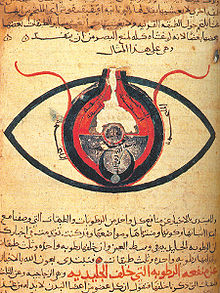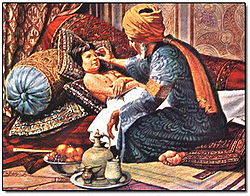- Ophthalmology in medieval Islam
-
Ophthalmology was one of the foremost branches in medieval Islamic medicine. The oculist or kahhal (کحال), a somewhat despised professional in Galen’s time, was an honored member of the medical profession by the Abbasid period, occupying a unique place in royal households. As such, medieval Islamic physicians are considered founders of ophthalmology as an independent discipline in its own right.[1] The specialized instruments used in their operations ran into scores. Innovations such as the “injection syringe”, a hollow needle, invented by Ammar ibn Ali of Mosul, which was used for the extraction by suction of soft cataracts, were quite common.
Muslim physicians described such conditions as pannus, glaucoma (described as ‘headache of the pupil’), phlyctenulae, and operations on the conjunctiva. They were the first to use the words 'retina' and 'cataract'.
Contents
Fertile grounds for emergence
The scientific achievements of the late Abbasid period may perhaps be attributed to the worldview that had developed as a result of the establishment of the House of Wisdom, and intermingling of scholars from India, Persia, North Africa and the west, in Baghdad.
Education and history
To become a practitioner, there was no one fixed method or path of training. There was even no formal specialization in the different branches of medicine, as might be expected. But some students did eventually approximate to a specialist by acquiring proficiency in the treatment of certain diseases or in the use of certain drugs.
Nevertheless it was standard and necessary to learn and understand the works and legacy of predecessors. Among those one can mention, The alteration of the eye by Yuhanna ibn Masawayh, whose work can be considered the earliest work on Ophthalmology, followed by Hunain ibn Ishaq, known in the west as Johannitius, for his work The ten treatises of the eye.
Cataract extraction
The next major landmark text on ophthalmology was the Choice of Eye Diseases written in Egypt by the Iraqi Ammar bin Ali Al Mawsili [1] who attempted the earliest extraction of cataracts using suction. He invented a hollow metallic syringe hypodermic needle, which he applied through the sclerotic and successfully extracted the cataracts through suction.[citation needed] He wrote the following on his invention of the hypodermic needle and how he discovered the technique of cataract extraction while experimenting with it on a patient:
"Then I constructed the hollow needle, but I did not operate with it on anybody at all, before I came to Tiberias. There came a man for an operation who told me: Do as you like with me, only I cannot lie on my back. Then I operated on him with the hollow needle and extracted the cataract; and he saw immediately and did not need to lie, but slept as he liked. Only I bandaged his eye for seven days. With this needle nobody preceded me. I have done many operations with it in Egypt."[2]Other contributions
Avicenna, in The Canon of Medicine (c. 1025), described sight as one of the five external senses.[3] The Latin word "retina" is derived from Avicenna's Arabic term for the organ.[4]
In his Coliget, Averroes (1126–1198) was the first to attribute photoreceptor properties to the retina,[5] and he was also the first to suggest that the principle organ of sight might be the arachnoid membrane (aranea). His work led to much discussion in 16th century Europe over whether the principle organ of sight is the traditional Galenic crystalline humour or the Averroist aranea, which in turn led to the discovery that the retina is the principle organ of sight.[6]
Ibn al-Nafis wrote a large textbook on ophthalmology called The Polished Book on Experimental Ophthalmology in which he made a number of original contributions to the field. The book is divided into two sections: "On the Theory of Ophthalmology" and "Simple and Compunded Ophthalmic Drugs".[7] Ibn al-Nafis discovered that the muscle behind the eyeball does not support the ophthalmic nerve, that they do not get in contact with it, and that the optic nerves transect but do not get in touch with each other. He also discovered many new treatments for glaucoma and the weakness of vision in one eye when the other eye is affected by disease.[8]
Other famous landmarks in ophthalmology include Rhazes’ Continens, Ali Ibn Isa’s Notebook of the Oculists, and the ethnic Assyrian Christian Jibrail Bukhtishu’s Medicine of the Eye, among numerous others.
Ottoman Empire
In the Ottoman Empire, and well into the Republic of Turkey of the 20th century, a class of ambulatory eye surgeons, popularly known as the ‘kırlangıç oğlanları’ (‘sons of the swallow’) operated on cataract using special knifes. From contemporary sources can be glimpsed that the reputation of these “blinding frauds” was far from spotless.[9]
Fees and income
There was a good deal of drama surrounding the men of medical professions in those days. A physician could on the one hand receive no less than an astronomical sum of 4,000,000 dirhams a year, as did Bukhtishu ibn Jurjis, the Assyrian Christian chief physician to the great Caliph Harun al-Rashid; or pay for the unfortunate death of his patient or failure of his treatment with his own life, as was often the case with physicians treating many a royalty.[citation needed]
But in general, the fee varied according to the status of the physician and the patient. The life of Ibn Masawayh, can perhaps be quite instructive in this regard: When still unknown and still a so called “road-side” physician in Baghdad, in return for successfully treating a servant suffering from Ophthalmia, he was paid with a daily allowance of bread and meat and sweets and a promise of a monthly salary of a few silver and copper coins. When The Vizier fell ill and Ibn Masawayh achieved similar success with him, his salary rose to 600 silver dirhams a month, food for two mules, and the services of five servants. And when he finally obtained the rank of chief ophthalmologist to the Khalifah, his salary was fixed at 2000 dirhams a month plus gifts valued at 20,000 dirhams a year, including forage for his mules as well as the services of a number of servants.[citation needed]
However, fees paid to ophthalmologists were measly in comparison to the elephantine fees which others were apt to receive overall. At the time when Ibn Masawayh received 2000 dirhams a month as ophthalmologist-in-chief to the Caliph Harun al-Rashid, Jibrail the physician was receiving 10,000 dirhams per month.[citation needed]
As to the means of obtaining the fee, in cases deemed chronic requiring multiple visits, they would receive the fee only on the fair conclusion of the case. If the patient recovered, there was, in most cases, no question of refusal to pay. But if the case ended fatally, then the relatives could if they so choose, show the chief physician of the city a copy of all prescriptions and medicaments which he ordered for the sick person. If the Hakim-bashi determined they were proper and fitting for the case and that the physician was exempt of any negligence or fault, he could declare that the person’s life had reached its allotted span by the will of Allah, and that the fees had to be paid in full. If on the other hand, the chief physician found evidence of neglect, he would direct the relatives to collect dieh (or blood money) for their kinsman from the physician, ‘for it is he who slew him by his poor skill and negligence.’
Nevertheless, some ophthalmologists would be fortunate enough to work as personal ophthalmologist to an Amir of good heart and intellect, and some Caliphs were even known to have kept a personal ophthalmologist in addition to a personal physician.
So well ingrained did the science of ophthalmology become in medieval Islamic culture that the word used for "wisdom" in Arabic is "al-Basirah", meaning the ability to see. In fact, one refers to loved ones as "Nour al-Ayni" meaning the light of my eyes.
Notes
- ^ David C. Lindberg (1980), Science in the Middle Ages, University of Chicago Press, p. 21, ISBN 0226482332
- ^ Finger, Stanley (1994), Origins of Neuroscience: A History of Explorations Into Brain Function, Oxford University Press, p. 70, ISBN 0195146948
- ^ Finger, Stanley (1994), Origins of Neuroscience: A History of Explorations Into Brain Function, Oxford University Press, pp. 71, ISBN 0195146948
- ^ Finger, Stanley (1994), Origins of Neuroscience: A History of Explorations Into Brain Function, Oxford University Press, pp. 69, ISBN 0195146948
- ^ Martin-Araguz, A.; Bustamante-Martinez, C.; Fernandez-Armayor, Ajo V.; Moreno-Martinez, J. M. (2002). "Neuroscience in al-Andalus and its influence on medieval scholastic medicine", Revista de neurología 34 (9), p. 877-892.
- ^ Lindberg, David C. (1981), Theories of Vision from Al-kindi to Kepler, University of Chicago Press, p. 238, ISBN 0226482359
- ^ Albert Z. Iskandar, "Ibn al-Nafis", in Helaine Selin (1997), Encyclopaedia of the History of Science, Technology, and Medicine in Non-Western Cultures, Kluwer Academic Publishers, ISBN 0792340663.
- ^ Mohamad S. M. Takrouri (King Khalid University Hospital Riyadh), Medical aspects of Ala al-Din Abu'l-Hasan Ali Ibn Abi'l-Haram al-Qurashi (Ibn al-Nafis)'s contributions to science
- ^ Laban Kaptein (ed.), Ahmed Bican, Dürr-i meknûn, p. 31f. Asch 2007. ISBN 9789090214085
References
- Ibn Abi Usaybi’ah, Uyun ul-Inba’ fi Tabaqat ul-Atibba, Cairo 1882.
- Nizami Arudhi, Chahar Maqalah. Gibb Series. London, 1921.
- Zeylessouf-ed-douleh, Matrah ul-anzār. Tabriz, 1916.
- Bar Hebraeus, Historia Dynastiarum, Edward Pococke's edition, Oxford 1663.
- M. Brett, W. Foreman. The Moors: Islam in the west. 1980.
- Cyril Elgood. A Medical history of Persia and the eastern caliphate : the development of Persian and Arabic medical sciences, from the earliest times until the year A.D. 1932. 1979.
- Casey Wood. Memorandum book of a tenth-century oculist for the use of modern ophthalmologists : a translation of the Tadhkirat of Ali ibn Isa of Baghdad (cir. 940-1010 CE).
See also
- Islamic medicine
- Islamic science
- Islamic Golden Age
- List of Arab scientists and scholars
- List of Iranian scientists and scholars
Medicine in the medieval Islamic world Physicians Concepts Psychology • Ophthalmology
Works The Canon of Medicine • Anatomy Charts of the Arabs • The Book of Healing • Book of the Ten Treatises of the Eye • De Gradibus • Al-Tasrif • Zakhireye Khwarazmshahi • Adab al-Tabib ("Practical Ethics of the Physician")
Centers Bimaristan • Nur al-Din Bimaristan • Al-'Adudi
Influences Influenced Categories:- Ophthalmology
- Islamic medicine
Wikimedia Foundation. 2010.


